
If you follow me, you know that I love films from Hollywood’s “Golden Age” as much as I treasure the costume jewelry produced at that time. Whenever I see a movie from that era, I’m always on the lookout for the jewelry the stars are wearing. Sometimes it is fine jewels from their own collections; at other times the pieces are costume. While recently watching The Woman in Green (Universal, 1945) on TCM, I spotted Hillary Brooke (the femme fatale) wearing a large brooch that I thought must be a Trifari. My research confirmed my hunch. Not only is it a Trifari jewel – it is a Trifari Jelly Belly clip shaped like a fish. Let’s look at the jewel, and then I’ll tell you about the movie.
Trifari Jelly Belly Jewelry
Trifari produced a line of animal brooches/clips made of metal or sterling with Lucite centers that became known as “Jelly Bellies”. Coro, Schreiner and other costume jewelry makers soon followed with their own versions of what were then called “Lucite jewels”. Trifari’s “first Jelly Bellies were manufactured in 1938-1939, though they reach peak diffusion in the period between 1943 and 1945” (Brunialti & Brunialti, ii, 172). One reason this material became so popular was its timing: it was a readily-available stand-in for crystals and diamantés that couldn’t be sourced from Europe during World War II. Trifari expanded its Jelly Bellies to include floral motifs and figurals (designs in the shape of an animal or person) in necklaces and earrings in addition to brooches and clips.
Brooke’s Jelly Belly clip is the “Sailfish”, designed by Norman Bel Geddes (1893-1958). According to the Encyclopaedia Britannica, he was a successful theatrical designer, producer and director as well as an industrial designer. In 1941, Design Patent number 129,165 was granted to Bel Geddes, who did not assign the rights to Trifari. (Throughout its operations, most design patents were in the name of Alfred Philippe, the company’s head designer.)
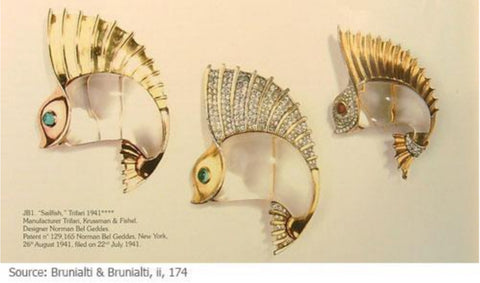
Shown here are three versions of the design produced by Trifari. On the left and in the center, the clips are 3 ¼ by 2 ½ inches and made in gold-plated base metal. The clip on the left has yellow- and rose-gold plated ribbed fins; the center piece has diamantés between the ribs.
The smaller version on the right is 2 ¾ by 2 ¼ inches and was made of gold-plated sterling with diamantés covering the face and encircling the tail. This variation “is a revisitation of the original design made in 1943, when Trifari produced its most important Lucite and sterling animal collection” (Brunialti & Brunialti, ii, 174). I think Brooke is wearing this one.
The Film
The Woman in Green (a rather curious title for a black-and-white film) was the eleventh in a series of Sherlock Holmes movies produced in the U.S. between 1942-1946, based on characters created by Sir Arthur Conan Doyle. Starring Basil Rathbone (as Holmes) and Nigel Bruce (Dr. Watson), this story involves the detective duo assisting Scotland Yard with solving the murders of four young women. What links the crimes is the fact that each victim is found with a severed finger.
The plot involves Lydia Marlowe (Hillary Brooke), a femme fatale who is a skilled hypnotist, and Professor Moriarty (Henry Daniell), Holmes’ nemesis and Lydia’s partner in crime. They engage in blackmail, commit numerous murders, and make several unsuccessful attempts on Holmes’ life.
Costumes
 Outfitted by Universal’s costume designer Vera West, Brooke’s wardrobe is befitting a femme fatale. This close-up shows her simple black suit accessorized with the Trifari clip as well as sparkling jewelled pins/clips on her hat. I cannot see them or her earrings clearly enough to even guess what they look like and who made them. Suggestions, anyone?
Outfitted by Universal’s costume designer Vera West, Brooke’s wardrobe is befitting a femme fatale. This close-up shows her simple black suit accessorized with the Trifari clip as well as sparkling jewelled pins/clips on her hat. I cannot see them or her earrings clearly enough to even guess what they look like and who made them. Suggestions, anyone?The Style
Brooke’s elegant costumes reflect the fashion silhouette of the 1940s war years – slim, well-tailored suits for day and long sheaths for evening – due to government restrictions. To achieve distinctive looks for their simpler clothing, women wore large brooches or clips on the shoulder of their day and evening attire. Today, we would call them “statement pieces”.
Although I cannot offer you a Jelly Belly clip, the boutique has many beautiful brooches and clips from the 1940s that add elegance to today’s fashions. Here are just a few of my favorites, fit for a femme fatale. All were made in sterling silver during World War II.
On the left is a tall and graceful (3 by 1 7/8 inches) stylized floral brooch by Mazer Bros. It features faux aquamarines and diamantés set in gold-plated sterling (vermeil). Next to it is a rose-gold-plated sterling calla lily brooch by Coro, with flowers in amethyst, ruby, and peridot glass. This jewel is 3 1/8 by 2 5/8 inches.
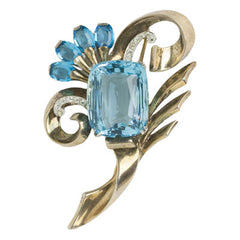 |
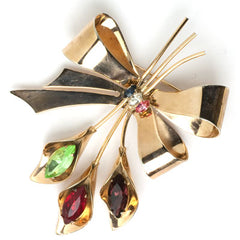 |
The clip on the left in rhodium-plated sterling is 2 by 2 ¼ inches and has faux emeralds accenting the diamantés. Though signed, I cannot identify the maker. In contrast is a sterling and diamanté leaf clip by Eisenberg. It’s exceptional in every way: size (3 ½ by 2 ½ inches), design and construction.
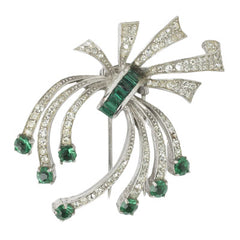 |
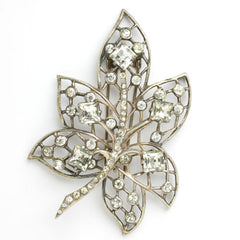 |
Shop the 1940s Jewelry collection for more brooches and clips, as well as necklaces, bracelets and earrings.
See the Film
Even if you’re a fan of the 1980s “handsome and scrupulously faithful series of Holmes adventures filmed for British television” (Maltin, 591), starring Jeremy Brett, you may find the Universal series amusing. If nothing more, you can admire the 1940s sets, costumes and jewelry. You might be surprised by what you see.
The Woman in Green is now in the public domain. Look for it on TCM or visit the Internet Archive.
Printed Sources Cited:
Brunialti, Carla Ginelli and Roberto Brunialti. American Costume Jewelry: Arts & Industry, 1935-1950. Schiffer, 2008.
Jorgensen, Jay and Donald L. Scoggins. Creating Illusion: A Fashionable History of Hollywood Costume Designers. Running Press, 2015.
Maltin, Leonard, ed. Leonard Maltin’s Clasic Movie Guide: From the Silent Era Through 1965. 2nd ed. Plume, 2010.

Leave a comment